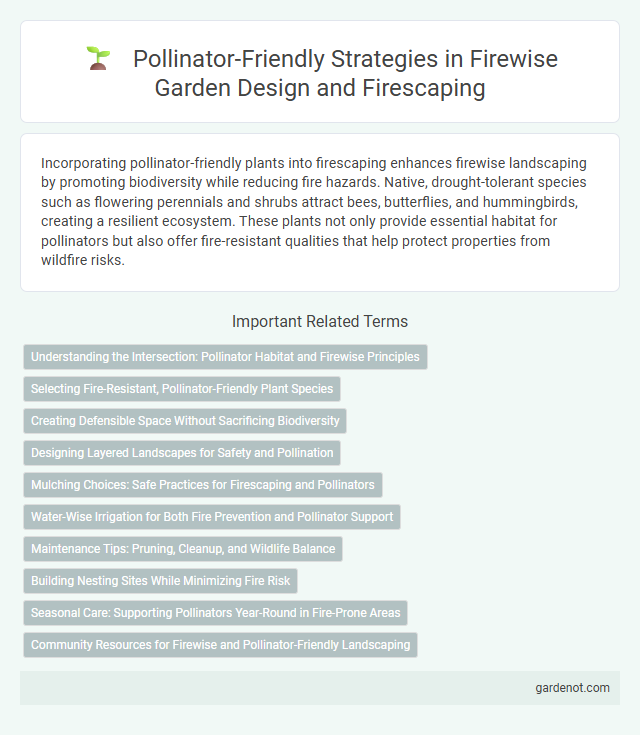Incorporating pollinator-friendly plants into firescaping enhances firewise landscaping by promoting biodiversity while reducing fire hazards. Native, drought-tolerant species such as flowering perennials and shrubs attract bees, butterflies, and hummingbirds, creating a resilient ecosystem. These plants not only provide essential habitat for pollinators but also offer fire-resistant qualities that help protect properties from wildfire risks.
Understanding the Intersection: Pollinator Habitat and Firewise Principles
Pollinator-friendly firewise practices integrate native, drought-resistant plants that support pollinator habitats while reducing wildfire risk through strategic spacing and regular maintenance. Emphasizing species like California lilac and manzanita enhances habitat connectivity and nectar availability without compromising defensible space around structures. Understanding the intersection of pollinator needs and firewise principles optimizes landscape resilience and biodiversity conservation in fire-prone regions.
Selecting Fire-Resistant, Pollinator-Friendly Plant Species
Choosing fire-resistant, pollinator-friendly plant species such as California lilac (Ceanothus), manzanita (Arctostaphylos), and sages (Salvia) enhances firewise landscaping while supporting vital pollinator populations. These plants possess low flammability due to their high moisture content and aromatic compounds that repel fire, making them ideal for creating defensible spaces in fire-prone areas. Incorporating native flowering species ensures habitat continuity for bees, butterflies, and hummingbirds while increasing landscape resilience against wildfires.
Creating Defensible Space Without Sacrificing Biodiversity
Pollinator-friendly firewise landscaping strategically incorporates native flowering plants and shrubs that resist wildfires and support essential pollinators like bees and butterflies. Creating defensible space involves clearing flammable vegetation while maintaining a diverse habitat to promote ecological balance and enhance fire resilience. Integrating drought-tolerant, low-growing species such as California lilac and manzanita improves safety without sacrificing biodiversity in fire-prone areas.
Designing Layered Landscapes for Safety and Pollination
Designing layered landscapes with pollinator-friendly firewise plants enhances fire safety while supporting essential pollination services. Incorporating native, drought-resistant species such as manzanita, ceanothus, and milkweed creates defensible spaces that reduce wildfire fuel loads and attract bees, butterflies, and hummingbirds. Strategic placement of flowering shrubs and groundcover maintains ecological balance, promotes biodiversity, and mitigates fire risks through thoughtful vegetation management.
Mulching Choices: Safe Practices for Firescaping and Pollinators
Mulching choices play a crucial role in firescaping by reducing wildfire fuel loads while supporting pollinator habitats through organic, non-toxic materials like wood chips and straw. Using mulch that retains moisture, such as shredded bark, helps create a fire-resistant zone around plants, enhancing safety without harming bees and butterflies. Avoiding synthetic or highly flammable mulches ensures protection for both property and essential pollinator populations.
Water-Wise Irrigation for Both Fire Prevention and Pollinator Support
Water-wise irrigation techniques enhance fire prevention by maintaining optimal soil moisture and reducing flammable dry vegetation. Implementing drip irrigation systems conserves water while supporting native pollinator habitats, promoting biodiversity within firewise landscapes. Selecting drought-tolerant, pollinator-attractive plants integrated with efficient watering schedules creates resilient environments that protect homes and sustain vital pollinator populations.
Maintenance Tips: Pruning, Cleanup, and Wildlife Balance
Effective firescaping prioritizes pollinator-friendly plants by incorporating regular pruning to reduce excess foliage and dead branches, minimizing fire risk while supporting native pollinators. Cleanup involves removing flammable debris like dry leaves and twigs without disturbing beneficial insect habitats, maintaining a balance between fire safety and ecological health. Promoting wildlife balance includes selecting fire-resistant plants that provide nectar and shelter, enhancing pollinator presence and contributing to a resilient, firewise landscape.
Building Nesting Sites While Minimizing Fire Risk
Creating pollinator-friendly firewise landscapes involves selecting native, fire-resistant plants that support diverse pollinator species while minimizing fire hazards. Incorporating natural nesting sites such as bee hotels, hollow stems, and undisturbed ground areas promotes habitat diversity without increasing combustible fuel loads. Strategic placement of these nesting structures within defensible space zones ensures both effective fire risk reduction and robust pollinator population support.
Seasonal Care: Supporting Pollinators Year-Round in Fire-Prone Areas
Pollinator-friendly firescaping emphasizes selecting native, drought-tolerant plants that bloom in succession, ensuring continuous nectar and pollen sources during fire season. Seasonal care involves strategic pruning and mulching to reduce fire hazards while preserving habitat structure vital for bees, butterflies, and hummingbirds. Regular monitoring and adaptive maintenance promote resilient plant health, supporting pollinator populations throughout the year in fire-prone landscapes.
Community Resources for Firewise and Pollinator-Friendly Landscaping
Community resources for firewise and pollinator-friendly landscaping provide essential guidance on selecting native, drought-resistant plants that reduce wildfire risk while supporting local pollinators. Educational programs and workshops often emphasize creating defensible space with fire-resistant vegetation that attracts bees, butterflies, and hummingbirds, enhancing ecosystem health. Local fire departments and environmental organizations collaborate to offer plant lists, landscaping tips, and grant opportunities to encourage sustainable, pollinator-friendly firewise landscapes in wildfire-prone areas.
Pollinator-friendly firewise Infographic

 gardenot.com
gardenot.com